last modified: Saturday, 12-Nov-2011 18:20:29 CET
Document status: complete
Ferruginous Quartz is a quartz that is more or less evenly colored in yellow, red, or brown tones by
inclusions of iron compounds, usually iron oxides and hydrous iron oxides.
Eisenkiesel (German for "iron pebble", pronounced "i-zen-keezle") is mostly used as a synonym, but some people refer to eisenkiesel as quartz that is evenly colored by
inclusions of hematite. The image to the right shows an evenly colored ferruginous quartz, a so called
Jacinto de Compostela in selenite matrix from Chella, Valencia, Spain.
On fairs you will see many nice orange quartz crystals (named "Orange Quartz", "Tangerine Quartz" and the like) that are colored by a coating of iron oxides but are white or colorless underneath. So these coatings are not included in the crystals and could be rubbed off or dissolved in an acid. As the coating precipitated on the crystal after it was grown and is not directly related to its formation and internal properties, this quartz should not be called eisenkiesel or ferruginous quartz.
Specific Properties
The
color varies between yellow, orange, red, and brown tones of different intensities. At many locations the crystals show a patchy coloration, sometimes even with different colors in one crystal. The specimen are usually
translucent to almost opaque, but never transparent.
Inclusions of other minerals influence the growth pattern of the crystals, and eisenkiesel crystals usually have a very simple crystal form. Typical specimen are short-prismatic, pseudo-hexagonal crystals without any accessorial crystal face.
Occurrence
Hydrous iron oxides form and precipitate from watery solutions at relatively low temperatures, whereas hematite can also form in high temperature environments. Thus, ferruginous quartz can often be found in sedimentary rocks in and near hydrothermal veins and in the iron hat (the weathering zone near the surface that is altered by oxidizing surface waters) of iron ore deposits.
Further Information, Literature, Links
Locations and Specimen
Ferruginous quartz is found at many locations worldwide.
Some of the best Eisenkiesel of deep orange and red color comes from Spain, here it is called Jacinto de Compostela. Very nice specimen with shiny short-prismatic orange-red crystals grown on botryoidal hematite came from Cumbria (or Cumberland) in Northern England. Interestingly ferruginous quartz is almost unknown in the Alps.
Germany
One
of the better known eisenkiesel locations in Germany is the fluorite mine area around Wölsendorf in the Oberpfalz at the northern end of the Bayerische Wald (Bavarian forest). Typical specimen consist of vein fillings of dark violet fluorite in granite that have been overgrown by dark brown and shiny quartz crystals. Some of the violet fluorite is visible at the lower left corner. This specimen is from the Johannesschacht. Donated by Berthold Weber.
This
a partial view of a quartz ball covered by brown crystals with patchy red inclusions of hematite from a dolomite/limestone quarry at Kallenhardt near Warstein in the Sauerland. It has been found in a hydrothermal vein in a fracture zone. The red inclusions are right below the surface, the core of the crystals is almost colorless but cloudy, surrounded by layers of increasingly yellow-brown color. The crystal surfaces have partially been roughened by dissolution processes. The crystals lack accessorial faces and are heavily twinned.
These
crystals have been retrieved from a large vein outlined by quartz crystals, just a few meters away from the location of the former specimen. The crystals are etched even more, but they are much larger and show an interesting artichoke growth pattern.
Inclusions
of goethite can cause a deep yellow color, as in this specimen from a quarry in Hohenlimburg-Oege in Hagen. The quartz crystals sit on a thin dolomite-quartz matrix which is covered by calcite crystals on the other side. The goethite has precipitated on colorless quartz crystals and has been overgrown again by clear quartz. On the left center of the specimen you can see that the growth did not continue evenly, but led to the formation of many smaller parallel-grown crystals on top of the rhombohedral faces.
A
detail view of the same specimen, showing the smaller parallel-grown crystals on top of the rhombohedral faces. The goethite is embedded between these small crystals and the colorless older crystals.
An
aggregate of tiny double terminated quartz crystals inside a small cavity in a matrix made of hematite, limonite and quartz. One can see crystals with inclusions of hematite (dark brown-red) or limonite (yellow), and some crystals with both hematite and limonite inclusions. The hematite is included as aggregates of small shiny flakes, whereas the limonite inclusions look a bit like a yellow sponge. The hematite seems to be more evenly distributed in the crystals, while the limonite is typically concentrated in the center of the crystals. The specimen is from a dolomite/limestone quarry at Kallenhardt near Warstein.
Namibia
This
image shows a ferruginous quartz containing an orange-red phantom made of hematite that precipitated on the crystal faces. The dark metallic spots at the left of the crystal are tiny hematite crystals, too. The specimen is from the Orange River in southern Namibia.
Prismatic
eisenkiesel crystals from the Orange River in southern Namibia. Like in the former specimen, the crystals contain layered, phantom-like, inclusions of hematite, although these are more patchy than in the former specimen. The core of the crystals is free of hematite and colorless or white. At the base of the crystals one can see smaller crystals sprouting from the prism faces, so this would qualify as candle quartz.
Russia
Ferruginous
quartz from Dalnegorsk, Russia, occurs in different habits, but elongated crystals - not really typical for ferruginous quartz - are most common. They have very often been covered by an opaline crust that is removed by dissolving the opal in hydrofluoric acid.
Spirifer Collection, Poland.
Spain
Jacintos de Compostela from Spain are a must-have for a quartz collector. They are of a very even and deep red-brown color, slightly translucent, and occur either as single, prismatic, double-terminated quartz crystals, or as flower- or hedgehog-like aggregates of shiny crystals that only show their rhombohedral faces. In both cases the individual crystals are quite small. Both types are found at Chella, a small village about 60 km south-west of Valencia. At least the double-terminated crystals grew within a rock matrix and represent
authigenic quartz.
Jacintos
can be found in the vicinity of Valencia, like the small double-terminated crystal in the first image from Chella. They frequently sit in a white to red-brown selenite matrix in Triassic sedimentary rocks.
A
larger, slightly translucent example from Chella. The prism faces lack their typical striations and are roughened, the prism faces are shiny.
The
second image shows a view of a larger matrix specimen with numerous double terminated crystals in a selenite matrix together with brown aragonite crystals.
Jacintos
can also show a patchy color. Since the growth took place in an environment of relatively low temperature (as indicated by the presence of both selenite and aragonite), the dark patches could be cloudy inclusions of organic matter, but that is pure speculation on my side.
This
quartz crystal "heart" is the first example of sparkling hedgehog-type Jacintos. The crystals are more shiny than the prismatic single crystals, and some of the crystal balls assume an almost metallic luster.
Another,
more irregular hedgehog Jacinto from Chella. The specimen is shown to the same scale as the heart-shaped one in the former picture.
A
crystal ball sits on transparent selenite crystals in a geode. The wall of the geode can be seen on the left side.
 Printer Friendly Version
Printer Friendly Version
Copyright © 2005-2013, A.C. A k h a v a n
Impressum
- Source: http://www.quartzpage.de/eisenkiesel.html

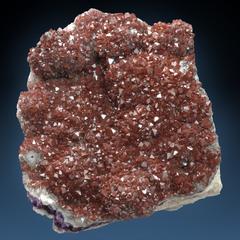

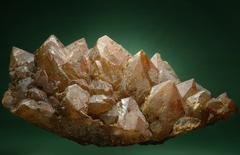
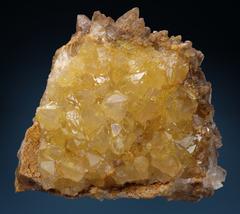
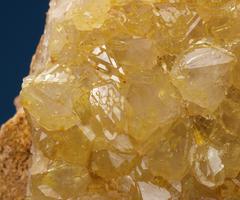
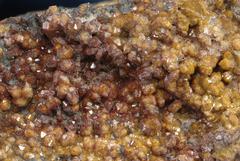
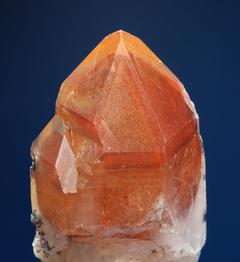
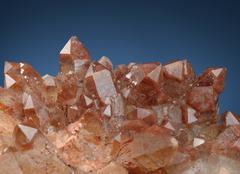
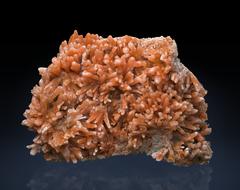







 Printer Friendly Version
Printer Friendly Version